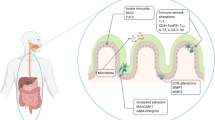Abstract
Mast cell degranulation in the gut causes mucus secretion, mucosal edema, and increased gut permeability and may be responsible for some of the symptoms and signs of inflammatory bowel disease. We have used a novel monoclonal antibody (AAI) against tryptase expressed exclusively in the granules of mast cells to enumerate mast cells in rectal biopsies in order to study the effect of inflammatory bowel disease and drug treatment upon rectal mast cell numbers. Rectal mast cell numbers are significantly reduced in inflammatory bowel disease patients taking corticosteroids (mean 4.95 cells/mm2) when compared with control patients (10.1, P<0.001) and inflammatory bowel disease patients not taking corticosteroids (9.7, P<0.007 Wilcoxon rank sum test). The reduction in mast cell counts was independent of the degree of inflammation or architectural distortion. There was a negative correlation between the dose of corticosteroids and mast cell count (r=0.53, P<0.05 Spearman rank correlation), and the mast cell count was reduced within a few days of treatment and remained low throughout steroid therapy. Mucosal mast cell depletion may be an important mechanism of action of corticosteroids in inflammatory bowel disease.
Similar content being viewed by others
References
Schwartz LB: Preformed mediators of human mast cells and basophils.In Mast Cells, Mediators and Disease. ST Holgate (ed). Dordrecht, Kluwer, 1988, pp 129–147
Robinson C: Mast cells and newly generated lipid mediators.In Mast Cells, Mediators and Disease. ST Holgate (ed). Dordrecht, Kluwer, 1988, pp 149–174
Plaut M, Pierce JH, Watson CJ, et al: Mast cell lines produce lymphokines in response to cross-linkage of FneER1 or to calcium ionophores. Nature 339:64–67, 1989
Jarrett EEE, Miller HRP: Production and activities of IgE in helminth infection. Prog Allergy 31:178–233, 1982
Haig DM, McKee TA, Jarrett EEE, Woodbury R, Miller HRP: Generation of mucosal mast cells is stimulatedin vitro by factors derived from T cells of helminth infected rats. Nature 300:188–190, 1982
King SJ, Miller HR, Newlnads GF, Woodbury RG: Depletion of mucosal mast cell protease by glucocorticosteroids: effect on intestinal anaphylaxis in the rat. Proc Natl Acad Sci USA 82:1214–1218, 1985
Strobel S, Miller HRP, Ferguson A: Human intestinal mucosal mast cells: Evaluation of fixation and staining techniques. J Clin Pathol 34:841–858, 1981
Befus D, Goodacre R, Dyck N, Bienenstock J: Mast cell heterogeneity in man: 1. Histologic studies of the intestine. Int Arch Allergy Appl Immunol 76:232–236, 1985
Shanahan F, MacNiven I, Dyck N, Denburgh JA, Bienenstock J, Befus AD: Human mast cells: Distribution and abundance of histochemically distinct sub-populations. Int Arch Allergy Appl Immunol 83:329–331, 1987
Otsuka H, Denburg J, Dolovich J, et al: Heterogeneity of metachromatic cells in human nose: Significance of mucosal mast cells. J Allergy Clin Immunol 76:695–702, 1985
Church MK, Benyon RC, Rees PH, et al: Functional heterogeneity of human mast cells.In Mast Cell and Basophil Differentiation and Function in Health and Disease. SJ Gali, KJ Austen (eds). New York, Raven Press, 1989, pp 161–170
Troncone R, Merrett TG, Ferguson A: Prevalence of atopy is unrelated to the presence of inflammatory bowel disease. Clin Allergy 18:111–117, 1988
Roberts DL, Rhodes J, Heatley RV, Newcombe RG: Atopic feature in ulcerative colitis. Lancet 1:1262, 1978
Otsuka H, Denburg JA, Befus AD, et al: Effect of beclomethasone dipropionate on nasal metachromatic subpopulations. Clin Allergy 16:589–595, 1986
Lloyd G, Green FHY, Fox H, Mani V, Turnberg LA: Mast cells and immunoglobulin E in inflammatory bowel disease. Gut 16:861–866, 1975
Bienenstock J: An update on mast cell heterogeneity. J Allergy Clin Immunol 81:763–769, 1988
Enerback L: Mast cells in rat gastrointestinal mucosa: 2. Dye binding and metachromatic properties. Acta Path Microbiol Scand 66:302–312, 1966
Walls AF, Bennett AR, McBride HM, Glennie MJ, Holgate ST, Church MK: Human mast cell tryptase: a biochemical marker for mast cell activation. Biochem Soc Trans 17:728–729, 1989
Walls AF, Bennett AR, McBride HM, Glennie MJ, Holgate ST, Church MK: Production and characterisation of monoclonal antibodies for human mast cell tryptase. Clin Exp Allergy, 1990 (in press)
Walls AF, Jones DB, Williams JH, Church MK, Holgate ST: Immunohistochemical identification of mast cells in formaldehyde-fixed tissue using monoclonal antibodies specific for tryptase. J Pathol 1990 (in press)
Harvey RF, Bradshaw JM: A simple index of Crohn's disease activity. Lancet 1:514–515, 1980
Enerback L, Pipkorn U: Nasal mucosal mast cells and histamine in hay fever. Effect of topical glucocorticoid treatment. Int Arch Allergy Appl Immunol 84:123–128, 1987
Weibel ER: Point counting methods. J Microsc 95:373–378, 1977
Author information
Authors and Affiliations
Rights and permissions
About this article
Cite this article
Goldsmith, P., McGarity, B., Walls, A.F. et al. Corticosteroid treatment reduces mast cell numbers in inflammatory bowel disease. Digest Dis Sci 35, 1409–1413 (1990). https://doi.org/10.1007/BF01536749
Received:
Revised:
Accepted:
Issue Date:
DOI: https://doi.org/10.1007/BF01536749




